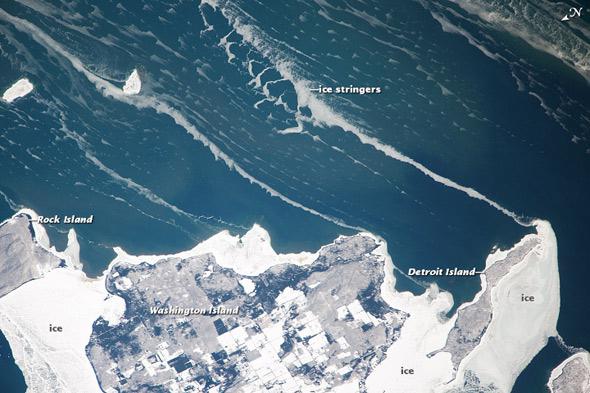One of the reasons NASA’s Earth Observatory Image of the Day—and there are many—is at the top of my feed reader is that sometimes it teaches me a whole thing I knew nothing about.
Like ice stringers!

Photo by NASA
That picture was taken by an astronaut on board the International Space Station and shows some small islands in Lake Michigan—for a sense of scale, the long skinny one on the right is Detroit Island, which is about 7 km (4.5 miles) long. The islands are connected by thick ice floating on the lake, so remind me to visit this place in the summer, not the winter.
Anyway, see those long, skinny, twisty white lines in the water? Those are ice stringers (probably not their official name, but EO used it and I like it); ice and snow blown into the lake by southwesterly winds (note that north is to the lower left in this picture). The ice starts on the islands, but the wind blows it onto the water from points that stick out into the water. As the EO site notes, the thickness of the stringer depends on the width of the source of the ice on land in the direction of the wind.
Trace each stringer back to its land source, to the lower right. The winds blow to the northeast (lower right to upper left), so look at the land source and slice it lower right to upper left. The skinnier stringers come from land sources with the thinnest slices (or more technically the shortest cross-section in the wind direction) and the opposite is true for the thicker stringers. Cool.
It’s interesting that the stringers don’t spread out much as they blow down wind; the thickness only increases a bit for the first several kilometers they blow. That may simply be due to the wind blowing in the same direction across a large area, so the ice particles don’t travel much in the direction perpendicular to the flow, so the stringers stay narrow. If so I’m surprised they can stay constrained like that for so long.
But note the curls at the edges of the stringers; those look like vortices caused by friction, slowing or speeding up the ice relative to the flow, causing them to curl away. It reminds me a bit of von Kármán vortices, though that’s a different effect. Anyway, that implies to me the wind is not all blowing at the same speed, perhaps indicating something else is keeping the stringers focused.
I wonder if the wind blowing around the land causes a Bernoulli effect, keeping the particles constrained …? Hmmm.* I’ve seen similar features like these stringers on a smaller scale, when wind blows fine dirt or sand around a building corner, or an obstacle like a rock on the ground. The physics of this sort of motion is surprisingly complex, but then it’s fluid dynamics, which involves very complicated math.
Speculation is fun, but it reminds me that there’s a lot to know about on this world of ours and not enough time to learn it all! This isn’t such a bad thing to be reminded of. I’d suggest checking in on the Earth Observatory every day. That’ll do the trick.
*Correction, March 23, 2014: In the original text, Bernoulli was spelled incorrectly.